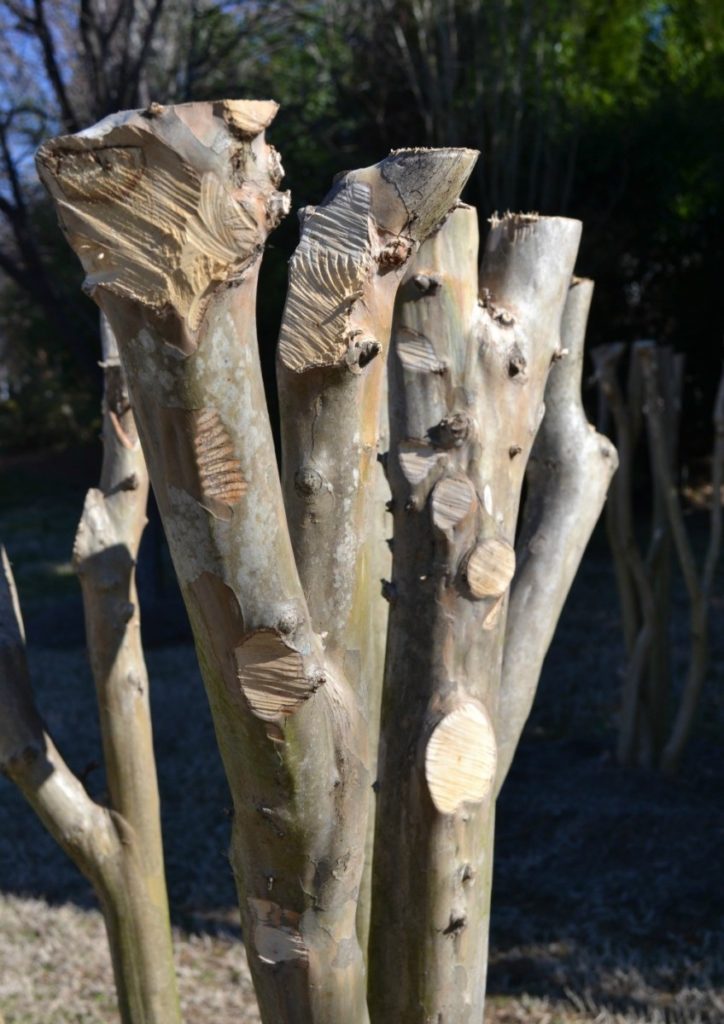Pruning season has kicked off with a fury, as all around I’m seeing crape myrtles with their proverbial heads lopped off. The most natural and beautiful crape myrtle trees result from limited or no pruning, yet one of the most common misconceptions I come across as a County Extension agent is that folks think crape myrtles require pruning to flower. I can assure you that this is not only fake news, but the notion has resulted in countless plants being “pruned” so aggressively that they can never recover fully from the damage.

Crape Murder” is a term credited to a 1997 article in Southern Living magazine that refers to the needless late fall and winter practice of cutting crape myrtles down to stubs.
The spectacle of which I’m referring is commonly referred to as “Crape Murder” and the practice leads to more harm than good. Severe pruning or “topping” of crape myrtles removes large portions of the tree’s developed scaffold branches and replaces that growth with weak shoots that are not strong enough to support the blooms in spring and summer. Cutting back the scaffold branches also prevents crape myrtles from forming the unique, exfoliating bark that gives the tree another layer of interest throughout the year. Lastly, these aggressive cuts do not heal well and often allow disease and rot to enter a crape myrtle.
When it comes down to it, improper pruning is a copycat crime and it’s something you should avoid doing with your trees. We prune trees to improve plant structure, eliminate plant defects, increase air circulation in the plant, and to reduce instance of disease. Each tree should be evaluated and individual assessed prior to making any type of pruning cuts. Even trees that are the same species will have their own unique form, and a given tree’s role will vary from one landscape to the next. Therefore, you need to figure out why you are pruning before you ever cut a branch. After all, you can always go back and cut more, but you cannot go back and cut less.
Fortunately, crape myrtles are resilient and can take a punch better than anyone. Sometimes, I’m truly amazed by what some of these trees live through when pruning season comes around. If your trees need some maintenance, start with removing any diseased, damaged, and inward growing branches. Also remove branches that cross or rub. If the plant growth is extremely dense, then you can thin the canopy, keeping in mind that the goal is cutting to see through them, not over them.
Use this phrase as a guide: “if a bird can easily fly through the center of your crape myrtle, then the branches are spaced about right.” For aesthetic reasons many folks also remove the spent seedheads but it is not necessary. If seedheads are out of reach just let them go.
Regarding existing trees that are too large for the space in which they are planted, there isn’t much that can be done, as it is far better to plant dwarf, or semi-dwarf varieties that grow to desired mature heights than to continue fighting with a more vigorous, larger cultivars planted in a too-small space. Bottom line – if your tree is too tall or threatens the structural integrity of your home, then you have it in the wrong place. Pruning to reduce height will only start a maintenance war that you will never win.
The best approach is to consider the projected size of the mature plant before installing it into the landscape. If you select a tree that will not outgrow its boundaries then it can display its graceful beauty with minimal pruning. There are many new cultivars in different sizes and colors. The dwarf (3 to 6 feet) and semi-dwarf (5 to 15 feet) selections now available make it easy to choose the right size plant for a certain space.
It is easy to get overwhelmed when pruning, especially if you lack experience. My advice is to go slowly and take the time to step back and look at your progress as you go. Remove limbs from the inside of the tree, especially limbs that cross or hang so low that they hit you in the face. If removing an entire limb is necessary, take care to not cut into the branch collar. If you leave a large stub, then four or five new shoots will grow in place of the one you removed.
For most of us I think it pays to spend a little extra time and prune our crape myrtles to a more natural form. I believe they set buds more quickly in the spring and the overall appearance is much better. Remember, just because you see other folks lopping off the heads of their crape myrtles doesn’t mean you have to as well. For more information on how to prune and care for your crape myrtles, as well as cultivar descriptions, refer to the UGA Extension Circular 944 “Crape Myrtle Culture.”